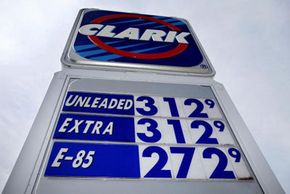Concerns about Cellulosic Ethanol
"Critics are plentiful out there," says Andy Aden, a process engineer who studies cellulosic ethanol production at the National Renewable Energy Laboratory in Golden, Colo.
One concern is the expense of production. Presently, cellulosic ethanol costs more to produce by the gallon than corn ethanol, which is more expensive than gasoline. In the United States, the price of corn ethanol is lowered artificially, thanks to a $0.51 tax credit for the entities who blend it with gasoline, which would also help cellulosic ethanol. Critics point to what most cellulosic ethanol refineries can't do: produce enough ethanol to sell to gas stations.
Advertisement
Optimistic researchers say production costs will drop as the production steps are revised. The U.S. Department of Energy set a benchmark for cellulosic ethanol to be competitive with gasoline by 2012, at a production cost of $1.33 per gallon. "We're still trying to hit that," says Aden. Four companies, which plan to open commercial-scale refineries in the United States in the next four years, at least see profit in trying.
"If you're going to produce biofuel from biomass on a very large scale, where is the land going to come from to grow it?" asks Aden, summarizing another concern about cellulosic ethanol. Some groups envision switchgrass spreading over the country like a weed and charge that energy crops will compete with food crops. Food and cellulosic biomass can come from the same plant if corn is food and the stalks are cellulosic biomass. Using "urban green," or yard waste to make ethanol requires no new land. Even in a planting scenario, switchgrass can grow on plots of soil too small or degraded to support food crops, where it will restore nutrients, says Aden.
Other critics consider rainforests. If developed countries supplement oil use with cellulosic ethanol, they'll export demand for cellulose to developing countries that have big forests. Those countries would make the fastest money by clear-cutting. However, it's not necessary to hack fresh trees for cellulose when common activities like farming, managing for forest fires and paper milling produce cellulosic biomass that's otherwise treated as waste. Governments can also regulate if and how rainforests are farmed.
Low fuel mileage is also a downfall for ethanol. Even if it costs less at the pump, your car will travel 25 percent fewer miles on a tank of E85 than on gasoline, says Aden.
The benefits and drawbacks are worth weighing, but cellulosic ethanol has to clear technical and economic hurdles before it shows up at a gas pump near you.
Keep reading for more links to the future of green technology.
Related HowStuffWorks Articles
- How Artifical Photosynthesis Works
- How EnviroGrid Works
- 5 Green Mobile Apps
- How Gasification Works
Sources
- Andy Aden. Personal interview. 5/13/2009
- BlueFire Ethanol. "Izumi Biorefinery." 2004. (5/22/2009) http://bluefireethanol.com/images/IZUMI_Status_2004_for_BlueFire_051606.pdf
- BlueFire Ethanol. "Technology." 2009. (5/22/2009) http://bluefireethanol.com/technology/
- Campbell, Neil A. et al. "Biology." Menlo Park: Benjamin/Cummings. 1999.
- Coordinating Research Council. "Fuel Permeation From Automotive Systems: E0, E6, E10, E20, and E85." December 2006. (5/22/2009) http://www.crcao.com/reports/recentstudies2006/E-65-3/CRC%20E-65-3%20Final%20Report.pdf
- Energy Information Administration. "How Dependent Are We on Foreign Oil?" April 23, 2009. (5/22/2009)http://tonto.eia.doe.gov/energy_in_brief/foreign_oil_dependence.cfm
- Energy Information Administration. "United States Energy Profile." May 15, 2009. (5/22/2009)http://tonto.eia.doe.gov/country/index.cfm?view=consumption
- National Renewable Energy Laboratory. "Ethanol Myths and Facts." Dec. 8, 2008. (5/22/2009)http://www1.eere.energy.gov/biomass/ethanol_myths_facts.html
- National Renewable Energy Laboratory. "Research Advances, Cellulosic Ethanol: NREL Leads the Way." March 2007. (5/22/2009)http://www.nrel.gov/biomass/pdfs/40742.pdf
- Renewable Fuels Association. "Renewable Fuels Standard." 2009. (5/22/2009)http://www.ethanolrfa.org/resource/standard/
- Schubert, Charlottte. "Can Biofuels Really Take Center Stage?" Nature Biotechnology. Vol. 24, no. 7. July 2006.
- U.S. Department of Energy. "ABC's of Biofuels." April 7, 2009. (5/22/2009) http://www1.eere.energy.gov/biomass/abcs_biofuels.html#prod
- U.S. Department of Energy. "Plant-to-Pump Infrastructure." May 6, 2008. (5/22/2009) http://www1.eere.energy.gov/biomass/plant-to-pump.html
- Waltz, Emily. "Cellulosic Ethanol Booms Despite Unproven Business Model." Nature Biotechnology. Vol. 26, no. 1. January 2008.
- Waltz, Emily. "Cellulosic Ethanol Stimulus." Nature Biotechnology. Vol. 27, no. 9. April 2009.
- Wang, Michael et al. "Life-cycle energy and greenhouse gas emission impacts of different corn ethanol plant types." Environmental Research Letters. Vol. 2, no. 2. April - June 2007.http://www.iop.org/EJ/article/-search=51073775.3/1748-9326/2/2/024001/erl7_2_024001.pdf?request-id=c657672c-3b1e-4914-824b-fe2bce0a26f0
- Yanowitz, Janet and Robert L. McCormick. "Effect of E85 on Tailpipe Emissions from Light-Duty Vehicles." Journal of the Air and Waste Management Association. Vol. 59, no. 2. http://www.afdc.energy.gov/afdc/pdfs/technical_paper_feb09.pdf
